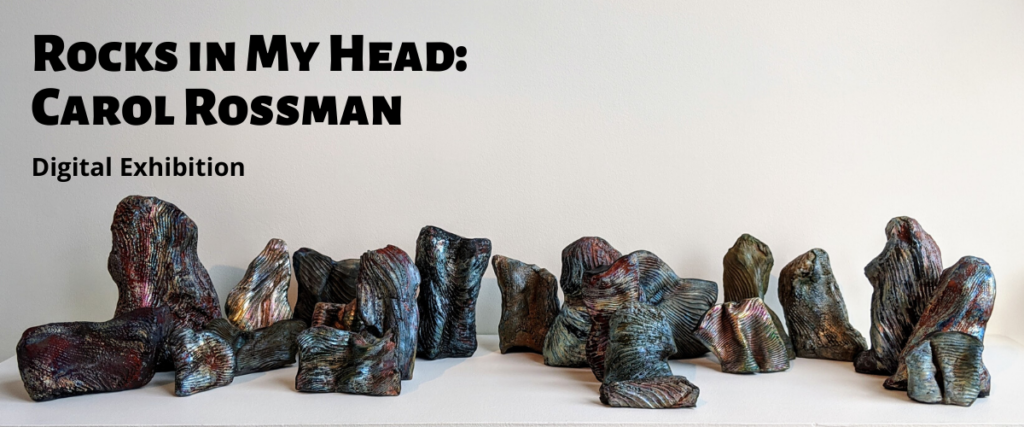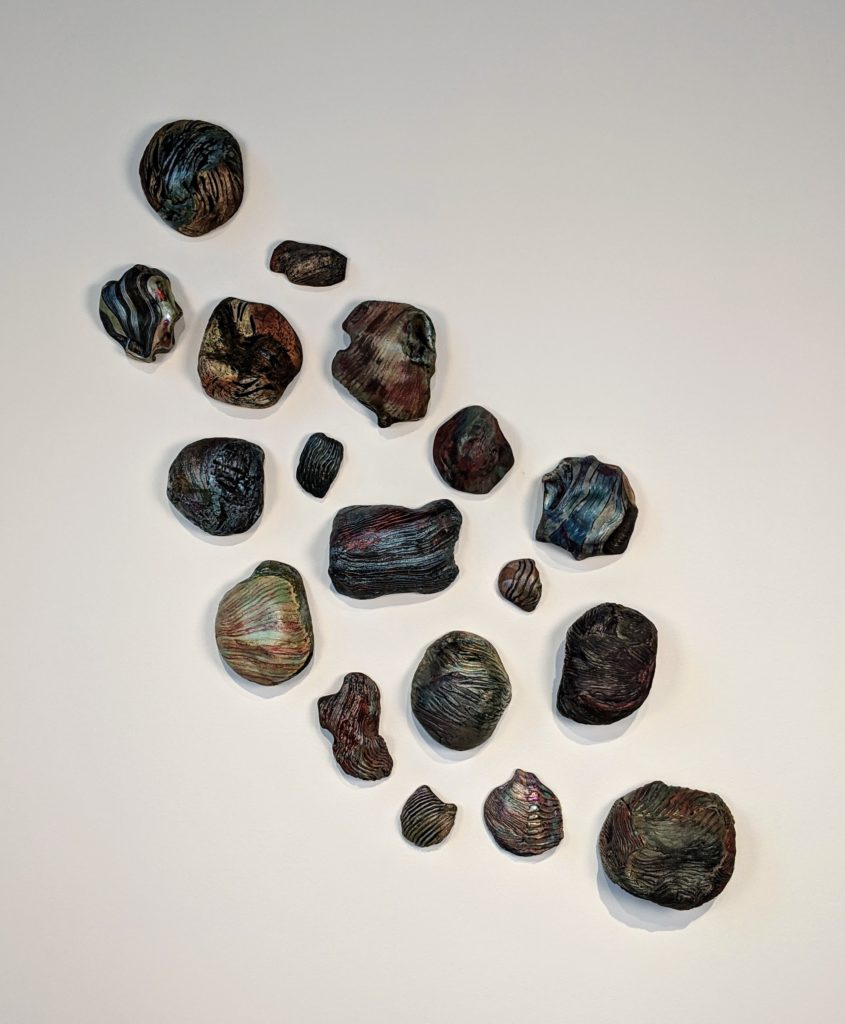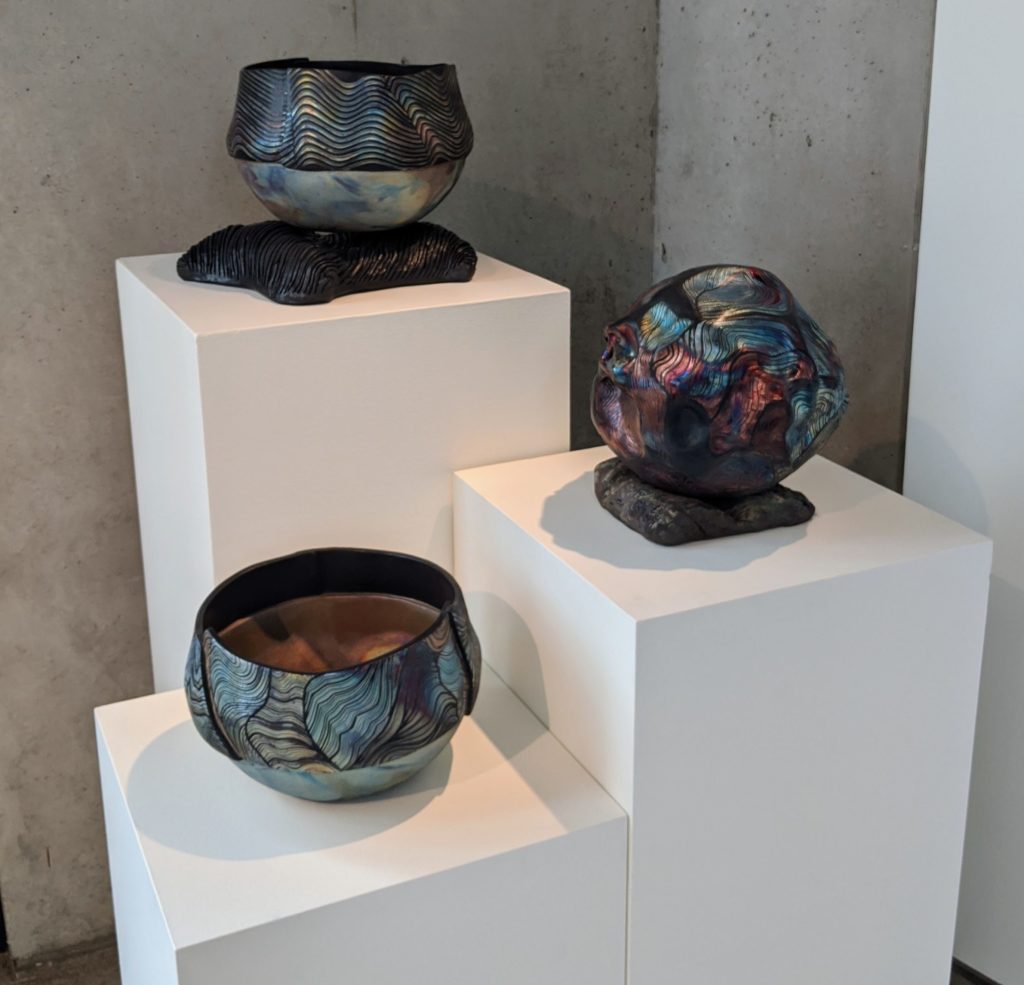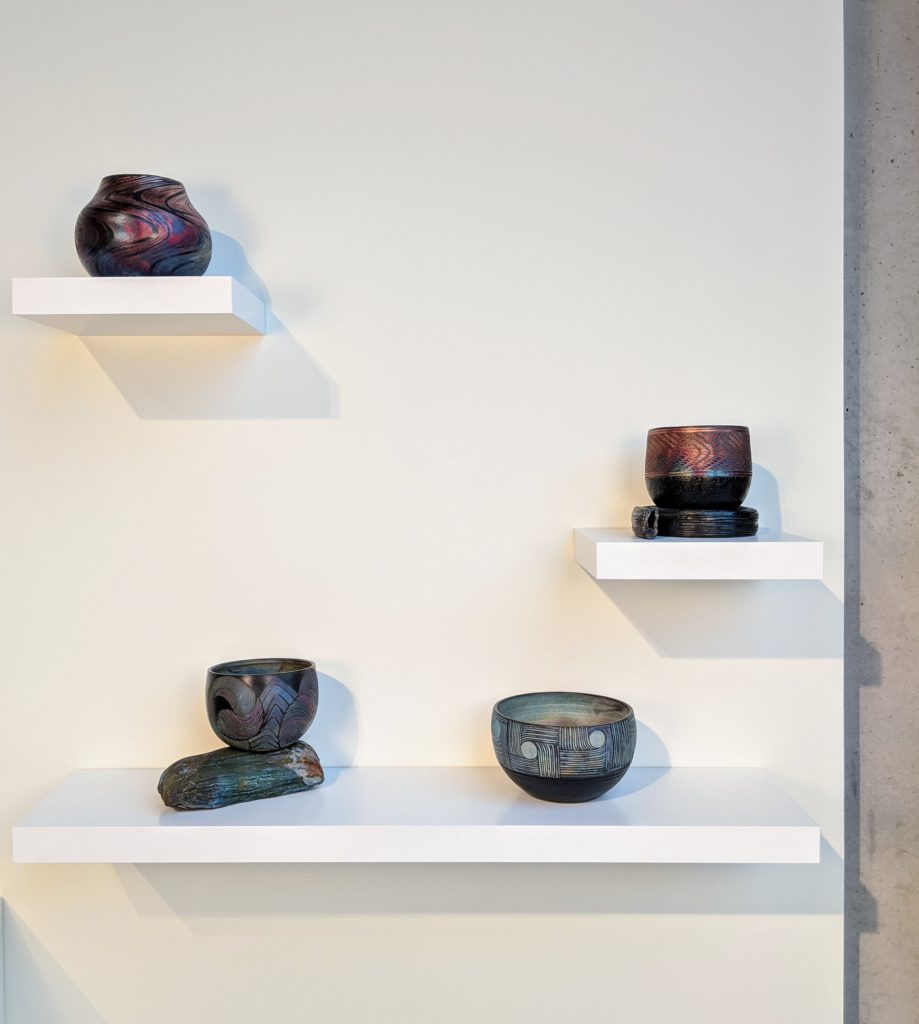
Des roches dans ma tête: Carol Rossman
Travaillant avec le raku, l’une des techniques les plus imprévisibles en céramique, la méthode scientifique et le décor soigneusement planifié de Carol Rossman donnent vie et formes naturelles aux vaisseaux et sculptures qu’elle crée. Rossman est influencée par le paysage du sud-ouest américain de l’Arizona, l’Utah, et du Nouveau Mexique où elle parcourt les sentiers à cheval annuellement. Dans son travail récent, elle capture les couleurs, les textures et les émotions de ces paysages uniques incluant les formations rocheuses et les canyons, la terre craquante du désert et la flore locale.
Rossman est une céramiste depuis plus de 40 ans. Influencée par sa carrière précédente de chercheure médicale à travers l’intense planification et expérimentation de sa technique, Rossman a maîtrisée la technique du raku d’unique façon. Et pourtant, l’imprévisibilité de cette unique façon de cuire le médium peut présenter des résultats uniques à chaque fois, créant une beauté sublime et une incertitude qui imite l’aspect naturel et invincible du paysage qui sont son inspiration et sa passion.
Foreword:
As part of its Emerging Talents program, the Canadian Clay and Glass Gallery is pleased to introduce Peter Flannery, recent graduate from the MA program in Art History and Visual Culture, University of Guelph. He is doing a curatorial and collections internship with us as part of the Canadian Museum Association, Young Canada Works Building Careers in Heritage program. As an emerging curator and writer, Peter is presenting the work of well-established ceramic artist Carol Rossman. The emerging talents series is presented in our Mutual Life Tower Gallery and is an ongoing program that will be managed by Peter as part of his internship. He will curate or facilitate the exhibitions and oversee the production of the accompanying publications. We wish to thank the Musagetes Fund of the Kitchener Waterloo Community Foundation and the C3 Group of Companies as well as the Canada Council for the Arts, the Ontario Arts Council and the City of Waterloo for their generous support.
Denis Longchamps, PhD
Executive Director and Chief Curator
Mastering the Unpredictable:
Carol Rossman’s American Southwest-Inspired Raku Wares
Anticipating and controlling the uncertain, or at least trying to, is perhaps the best way to describe Carol Rossman’s raku practice. A technique often known for its unanticipated results and the difficulty of achieving the same product more than once, raku can be a challenging art to master. However, a command of the medium is certain in the pots and natural forms that convey Rossman’s attention to detail and appreciation of the landscapes of the American Southwest. Through annual trail riding trips to Arizona, Utah, and New Mexico, a deep relationship with the canyons and rock formations inform the works included in this installation.

Within each of Rossman’s pieces, direct references to the natural environment await discovery, as she brings the shapes, patterns, and colours of the American Southwest to her vessels and sculptural works. Layers of sediment, tall, human-like hoodoo forms, and bristlecone pine trees with their twisting trunks are evident in the varied forms that she creates. While the oxides that leach out of smooth, curving, canyon walls, stain the surrounding rock in deep red and mango coloured tones in a phenomenon Rossman refers to as “nature’s paintbrush” is brought to life through her glazing and firing process. Works for this installation draw inspiration from Antelope Canyon, Arizona and Rattlesnake Canyon, Utah in particular, as Rossman continues her exploration of the landscapes that define and enliven her favourite places to be as she combines her immense experience in raku firing with new techniques and forms like crawling glazes and towering forms.

First, a medical researcher, who later turned her hobby of ceramics into a second career, Rossman has applied her passion for experimentation, detail, and documentation to the unpredictable craft of raku. Her practice begins by throwing or hand-building the form for her work which is then covered in terra sigillata, a thin layer of liquid clay slip, and polished to create a smooth sheen before bisque firing. After the piece has been fired, Rossman begins to develop the intricate decoration for the piece based on the shape of the form. She carefully masks the areas that will remain unglazed with black tape, creating repeating graphic designs and flowing lines. The uncovered areas are then applied with glazes and oxides, often up to five layered in a single section to achieve the desired colours and textures.
Before firing, the black tape is removed, leaving these areas of the clay uncovered so that they will blacken from the carbon in the smoky reduction chamber. The pieces are heated in a kiln to 1,000 degrees Celsius before they are removed while still red-hot and placed in the reduction chamber filled with combustible materials like newspaper or sawdust, the most critical part of the raku process. Inside the chamber, the mix of glazes and oxides, in combination with the right timing and proportions of oxygen and fire, work together to produce magenta, blue, turquoise, gold, or orange colours within the glazes. The post-firing process must then be stopped at just the right moment to ensure that the desired colours are still present once the reduction chamber has completely cooled.
Rossman has certainly mastered her technique of raku-firing, in part, through her research experience and the creation of a notebook in which she meticulously documents the creation of each test piece. Through photos, sketches, and notes, she identifies the glazes and oxides that were applied in each section of a piece, the firing process, and the result. This enables her to accurately reproduce the texture and colours that she desires in later works, taking some of the guesswork and unpredictability out of the raku process. And yet, surprises still appear when the reduction chamber lid is removed as slight variations can produce the most unpredictable results. For Rossman, the process thus becomes one of careful planning and intentional choices, but also one in which the small joys of unexpected results still appear as the carbon is carefully cleaned from the surface of her works to reveal the glazes underneath.


Drawing from the American Southwest landscapes, Rossman’s raku pots and geologically inspired forms recreate and elaborate upon the natural environment in an expression of the spaces where she feels most at ease. An area of subtle, yet deeply moving beauty, the canyons and formations of Utah and Arizona where Rossman rides are carefully represented in her detailed works that take the sublime forms of the power of nature and translates them into smaller, hand-built objects. Through the rough and sharp textures in combination with smoothly curving vessels, the textures connect the variety of immense natural forms in compelling dichotomies. Immediately evoking a sense of calm and an appreciation of the land through their refined forms and decoration, her raku wares benefit from the hours of careful experimentation and planning that produce both certainty and unanticipated results in the many contrasts that allow the works to depict their natural inspirations.
This makes raku perhaps the ideal medium for Rossman’s creative exploration, as the natural and unexpected developments of her vessels and sculptures mimic the unpredictability and untamed beauty of the natural environment, particularly one as raw and unchanged as the American Southwest. In the contrasts between soft and hard, geometric and organic, smooth and rough, planned and unanticipated, the vessels and sculptures elaborate on the relationships between human intervention and natural beauty that are at the heart of Rossman’s practice. One in which the natural is controlled, and yet the unconquerable aspects of the environment leave an element of uncertainty that can create a surprise of sublime beauty at any turn.
Peter Flannery, Curator

Peter Flannery
Peter Flannery is an emerging curator, writer and art historian. In 2019, he completed his Master of Arts in Art History and Visual Culture at the University of Guelph. His thesis, The Aesthetics of Collective Identity and Activism in Toronto’s Queer and HIV/AIDS Community considers the impacts of art from the 1970s to today on the development of queer identities, communities, and the HIV/AIDS crisis. Peter is currently the Curatorial and Collections Intern at the Canadian Clay and Glass Gallery and has previously worked at the Woodstock Art Gallery, the Art Gallery of Guelph, Renann Isaacs Contemporary Art, and the McLaughlin Library Archival and Special Collections.
Carol Rossman
Carol Rossman has been potting since 1973, and selling professionally since 1985. Carol has been selected for many group shows in Toronto, London, and The Ceramic Art Gallery in Australia; and solo shows including recent exhibitions at The Canadian Guild of Craft in Montreal, the Carnegie Gallery in Dundas, and the David Kaye Gallery in Toronto. She has won numerous awards for her work. Her work is held in collections across Canada, the United States, Great Britain, Kuwait, and Japan. Rossman’s work has appeared in numerous publications including National Ceramics and Ceramics Monthly and five textbooks. In 2013, a book was published about her work: Carol Rossman, by Jonathon Bancroft-Snell.
Sponsored by:


